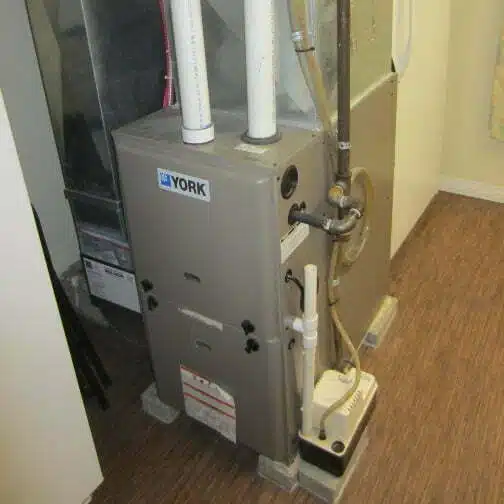heating FAQ
When Should You Replace Your Furnace?
Short Answer: Typically, a furnace should be replaced every 15 to 20 years, or sooner if there are persistent issues like frequent repairs, increasing energy bills, inconsistent heating, or strange noises. A timely replacement ensures efficient heating and potentially lowers costs.

There’s no doubt about the central role a well-functioning furnace plays in our homes. It provides the warmth we need, especially during the cold winter months, and contributes to the overall comfort and convenience of our daily lives. However, like all machines, a furnace has a limited lifespan and will eventually need replacing. But when is the right time to replace your furnace?
Understanding the Lifespan of a Furnace
A furnace typically lasts between 15 to 20 years, but this can vary depending on several factors, such as the specific brand, how often it’s used, and how well it’s maintained. Regular and proper maintenance can significantly prolong the life of your furnace and keep it running at optimal efficiency.
Signs Your Furnace May Need Replacing
Recognizing the signs that your furnace may need replacing is crucial in preventing further damage and potential health risks. Below are some indicators that your furnace may be nearing the end of its lifespan:
- Increased Heating Bills: If your energy bills are continuously rising despite consistent usage, your furnace’s efficiency may be declining, indicating that it may be time for a replacement.
- Inconsistent or Insufficient Heat: If you notice some rooms in your home are colder than others or the furnace can’t keep up with your heating needs, it’s a clear sign your furnace is struggling.
- Frequent Repairs: If your furnace needs frequent repairs, especially if those repairs are becoming increasingly costly, this is a strong indication that your furnace may need replacing.
- Strange Noises or Smells: Unusual noises like rumbling, popping, or screeching, or strange smells coming from your furnace can signal serious issues.
- Health Symptoms: Frequent headaches, burning eyes, nausea, or increased allergies could potentially be a sign of a carbon monoxide leak from an old or malfunctioning furnace. If you experience these symptoms, seek professional help immediately.
The Costs of Keeping an Old Furnace
Holding onto an old, failing furnace can become an expensive affair. As the furnace ages, its efficiency drops, leading to higher energy consumption and, consequently, increasing your heating bills. Furthermore, frequent repairs and part replacements can quickly add up. Comparatively, a new furnace, while an upfront investment, offers greater energy efficiency, reducing your monthly bills and potentially saving you money in the long run. Additionally, an older, less efficient furnace tends to have a higher environmental impact due to increased energy consumption.
Assessing Your Furnace’s Efficiency
Assessing your furnace’s efficiency can be key to determining whether or not it needs to be replaced. Here are several ways to evaluate it:
- Monitor Energy Bills: An increase in your energy bills when your usage hasn’t changed significantly may suggest your furnace’s efficiency is decreasing.
- Age of the Furnace: If your furnace is approaching or has surpassed its expected lifespan of 15 to 20 years, its efficiency is likely lower than that of newer models.
- Uneven Heating: If some areas in your home are hotter or colder than others, it might be because your furnace isn’t distributing heat as efficiently as it should.
- Frequency of Repairs: A furnace needing constant repairs is likely not operating at its maximum efficiency.
- Professional Assessment: A heating professional can conduct a thorough efficiency test, examining your furnace’s combustion efficiency and ensuring it’s working optimally.
When to Consult a Professional
If you observe any of the signs mentioned above, it’s recommended to consult a professional. During a furnace assessment, professionals inspect the unit, identify any issues, and advise whether it’s more cost-effective to repair or replace the unit. Regular maintenance and professional checks are crucial, as they can detect problems early on, possibly extending the life of your furnace and keeping it running safely and efficiently.
Choosing a New Furnace
If you’ve determined it’s time to replace your furnace, several factors should guide your decision. Consider the energy efficiency of the new unit – higher efficiency means lower energy costs over the unit’s lifespan. The size and capacity of the furnace should be appropriate for the size of your home to ensure effective and efficient heating.
Brand and warranty are also significant factors; reputable brands often offer longer warranties and better post-purchase service. Once you’ve chosen your new furnace, prepare for the installation process, which typically involves removing the old unit, installing the new one, and testing it to ensure proper function.
Conclusion
Paying close attention to your furnace’s performance and knowing the signs of a failing unit can save you time, money, and a lot of inconvenience down the line. When the time comes, don’t hesitate to replace your furnace. An efficiently functioning furnace is not just about comfort; it’s also about safety and efficiency. If you suspect your furnace needs replacing, don’t delay in consulting a professional. Remember, an investment in a new furnace is an investment in a comfortable, warm, and energy-efficient home.
